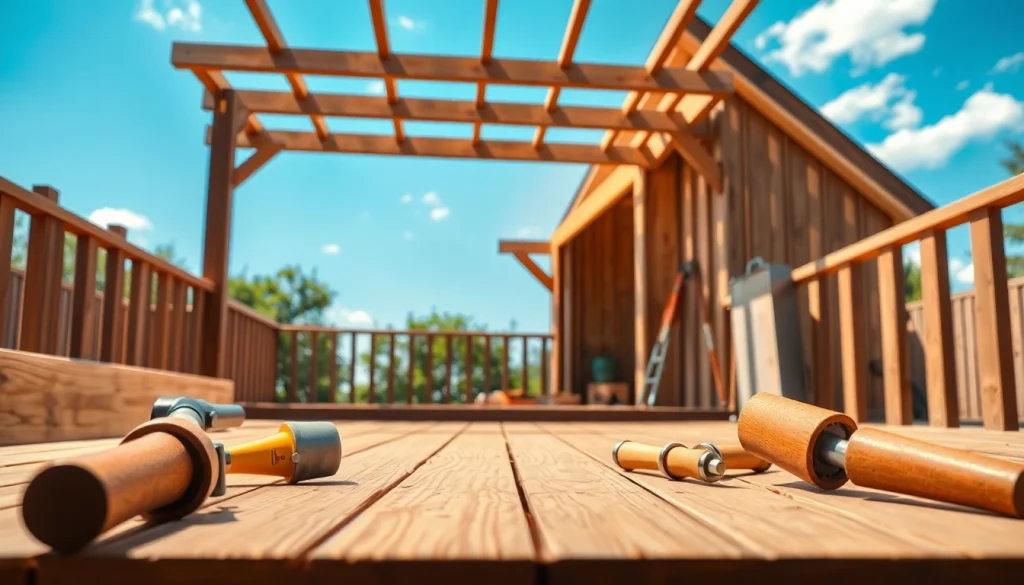Introduction to Deck Construction
Deck construction is more than just adding an outdoor space; it’s about enhancing your home’s aesthetics, creating a gathering area for family and friends, and increasing property value. Whether you’re building a simple deck for relaxation or a multi-level outdoor haven, understanding the basics is crucial to success. This comprehensive guide covers everything you need to know about deck construction, from planning and design to maintenance and care.
Understanding the Basics of Deck Construction
Decks are outdoor structures attached to or surrounding a home, typically made of materials such as wood or composite. The basic components include the framing (posts, beams, and joists), the surface (decking), and railings for safety. The building process starts with assessing your space’s layout, zoning requirements, and soil conditions which are fundamental to creating a safe and sturdy deck.
Importance of Quality Materials in Deck Building
Choosing high-quality materials is paramount to the longevity and durability of your deck. Common materials include:
- Pressure-treated wood: Inexpensive and commonly used, it resists rot and insects but may warp over time.
- Composite decking: Made from a blend of plastic and wood fibers, it offers durability and lower maintenance.
- Hardwood: Options like Ipe or Teak are naturally resistant to rot but can be costly.
Each material has unique properties, costs, and maintenance requirements, so carefully evaluate them according to your budget and climate.
Overview of Local Building Codes
Local building codes dictate the standards for deck construction, which include permits, materials used, and safety regulations such as railing height and load specifications. Always check with your local building authority to ensure compliance. This not only helps avoid fines but also ensures your deck is built safely and correctly.
Planning Your Deck Design
Key Considerations for Deck Placement
When planning your deck, consider the following factors:
- Sunlight: Observe how sunlight moves throughout your yard to choose the best placement for comfort.
- Access: Ensure easy access from your home, considering existing landscaping and paths.
- View: Position the deck for the best outdoor views while considering privacy.
Choosing the Right Materials for Your Deck
Material selection can significantly impact your deck’s look, feel, and functionality. Consider the pros and cons of available materials:
- Wood: Provides a classic aesthetic but requires regular staining and sealing.
- Composite: Offers a versatile appearance with minimal upkeep, resistant to fading and scratches.
- Aluminum: Lightweight and long-lasting, but can be more expensive.
Creating a Budget for Your Deck Project
Establishing a realistic budget is vital for a successful deck construction project. Consider all costs involved, including:
- Materials
- Labor
- Permits
- Tools and equipment rentals
Seek multiple quotes if hiring contractors, and consider DIY options to save costs.
The Deck Construction Process
Essential Tools for Deck Building
Before commencing construction, ensure you have the following tools:
- Measuring tape
- Level
- Power drill
- Circular saw
- Screwdriver
- Safety equipment
Having the right tools will improve efficiency and safety during the construction process.
Step-by-Step Instructions for Deck Framing
The framing stage is crucial as it supports the entire deck structure. Follow these steps:
- Mark the Layout: Use stakes and string to outline the perimeter of your deck.
- Excavate Post Holes: Dig holes for the posts at least 36 inches deep to below the frost line.
- Set the Posts: Use concrete to securely set your vertical posts in place.
- Add Beams: Attach horizontal beams at the top of the posts using brackets.
- Install Joists: Space joists 16 inches apart, secured to the beams for sturdy flooring.
Finalizing the Deck Surface and Railings
Once your framing is up, it’s time to complete your deck:
- Lay Decking Boards: Begin laying your chosen decking material perpendicular to the joists, leaving space for water drainage.
- Attach Railings: Ensure safety by adding railings at the appropriate height and spacing.
- Finish Details: Sand edges, apply finishes, and add any extras like built-in seating or planters.
Deck Maintenance and Care
Best Practices for Deck Upkeep
Proper maintenance will extend your deck’s life. Here are some best practices:
- Clean the deck regularly using a broom and a mild detergent.
- Inspect for signs of damage, such as splintering or loose boards, and address issues immediately.
- Apply sealant or stain every few years to protect wood from moisture and sun damage.
Common Issues to Watch for in Decks
Vigilance in monitoring the following common problems ensures safety:
- Wood Rot: Look for soft, spongy areas that indicate rotting wood, particularly around posts and joists.
- Rusty Fasteners: Check screws and brackets regularly for rust, which can compromise structural integrity.
- Loose Railings: Regularly verify that railings are secure to prevent accidents.
Seasonal Maintenance Tips for Longevity
Seasonal maintenance is essential for deck longevity:
- Spring: Inspect for winter damage and clean thoroughly.
- Summer: Apply protective sealants and treat any pest infestations.
- Autumn: Clear leaves and debris to prevent moisture buildup.
- Winter: Remove snow to avoid excess weight and prevent ice from forming.
Conclusion and Next Steps
Evaluating Your Deck Construction Experience
After completing your project, take time to evaluate your experience. Consider what went well, what challenges you faced, and what you would do differently next time. This reflection will help you grow as a DIY enthusiast or contractor.
Resources for Further Learning
Expand your knowledge by tapping into resources available online or through home improvement stores. Look for tutorials, workshops, and instructional videos that offer comprehensive insights into both advanced and basic deck construction techniques.
When to Call a Professional for Help
While many homeowners can DIY their decks, certain scenarios warrant a professional’s assistance:
- If your deck design is complex or involves multiple levels.
- When local building codes require expert knowledge for compliance.
- If you lack the tools or skills necessary for specific construction stages.
Deploying the right balance of DIY effort and professional guidance can lead to a successful and satisfying deck construction project.


